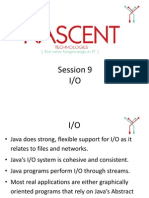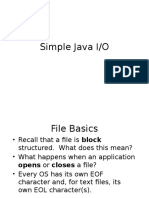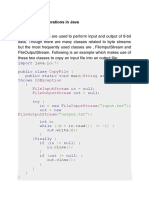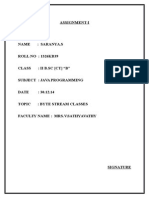0% found this document useful (0 votes)
17 views50 pagesJava IO
The document provides an overview of file handling in Java, detailing the concepts of streams, types of files (binary and text), and the classes used for input and output operations. It explains the differences between byte and character streams, the importance of buffering, and how to properly open, use, and close file streams. Additionally, it covers exception handling related to file I/O and demonstrates how to read from and write to text files using various classes.
Uploaded by
sayanshit171Copyright
© © All Rights Reserved
We take content rights seriously. If you suspect this is your content, claim it here.
Available Formats
Download as PPT, PDF, TXT or read online on Scribd
0% found this document useful (0 votes)
17 views50 pagesJava IO
The document provides an overview of file handling in Java, detailing the concepts of streams, types of files (binary and text), and the classes used for input and output operations. It explains the differences between byte and character streams, the importance of buffering, and how to properly open, use, and close file streams. Additionally, it covers exception handling related to file I/O and demonstrates how to read from and write to text files using various classes.
Uploaded by
sayanshit171Copyright
© © All Rights Reserved
We take content rights seriously. If you suspect this is your content, claim it here.
Available Formats
Download as PPT, PDF, TXT or read online on Scribd
/ 50

























































































